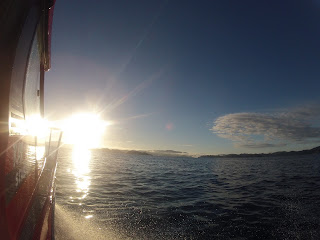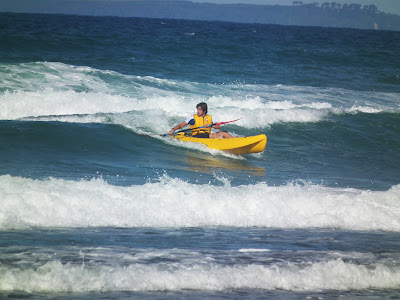Now six months into my Kiwi adventure, the journey I’ve embarked
upon has been as much a slingshot up a learning curve as a trundle across New
Zealand. In this post, I’ve selected just a few of the quirky things - some peculiar to NZ,
some applicable to life as a whole - that I've picked up from people and experience along the way.
Fishing in New Zealand isn't just a hobby, it's a integral part of kiwi
lifestyle and culture. "The most important things in New Zealand are your
boat and your bach" observed one Bay of Islander I spoke to. Almost every household
in the country seems to have some seagoing vessel or other trailered up in
their driveway, and every weekend boat ramps and fishing spots swarm with
activity, abuzz with the whir of 2-stroke engines. Harbour fronts and jetties
are populated by parents teaching their toddlers the basics of angling, and at every rocky atoll you come to there is always a lone fisherman stood stoically beside a 12ft surf-casting rod while the waves burst over him. Though not
quite as hardcore, I've gone from knowing zilch about catching a fish to being
able to paddle out on our kayak, catch, gut, fillet, and cook in as many ways as you'd care to mention.
We've fried it, barbecued it, steamed it, chowdered it, smoked it and
even eaten it raw, marinated in lemon juice and coconut milk. Delicious.
2. Anyone performing the Haka is terrifying, no matter who they are.
Whether you’re watching the All Blacks, a show at a traditional Maori
‘village’, or a tribe of school kids stamping their feet, grasping the air and
chanting in unison, a Haka is always fearsometo behold. I happened across a
school performance in central Rotorua, and can confirm that, despite the fact
the kids can’t have been much older than eleven or twelve, it genuinely scared
me. It’s a display of practice, discipline and ferocity, and I for one would not have anything with which to display in answer.
Though lumpy, misshapen, and with all the aesthetic
appeal of a bull’s scrotum, Kumara are downright delicious.New Zealand’s
sweet potato will enhance any recipe when used as a replacement ingredient to
your bog-standard king Edward, but best prepared in a Hangi (a geothermal
oven/hole in the ground).Watch your vitamin-A levels and the smile on your face
grow as you munch.
4. There are very few issues that can’t be solved with a chainsaw.
This seems to be a logic held by most Kiwi blokes. Before heading out to New Zealand, I had expected to end up falling into a culture of holistic communes, dreadlocks, and people who insist on slinging fire-poi around a beach as soon as the sun sets. In reality, New Zealand is a society built on manliness, on things that guzzle petrol and make loud noises. It’s flannel shirts, beards, and more tree management companies than you can shake a Manuka branch at. I’d stab an educated guess that at least eighty per cent of any commercial break on NZ television is made up of advertisements containing men shouting loudly about power tools.
 5. It’s impossible to judge a drive time by looking at a road atlas in
New Zealand.
5. It’s impossible to judge a drive time by looking at a road atlas in
New Zealand. New Zealand has over two thousand miles less motorway than the United Kingdom, meaning that even the most major highways in the country don’t cleave their way through the hills – they wind and knot their way up the slopes instead, often in the most bizarre, precarious route possible. Sadly, road maps here are rarely detailed enough to reveal the fact that what appears to be a course of flat, straight asphalt on the page is, in fact, a thousand metre climb and descent made in a noodle of hairpins. Consequently, what you predict to be an hour’s easy cruise can unexpectedly become three hours of engine-straining, hair-raising motoring without warning. Nice views though.
That’s right, the humble Kiwi has an unlikely contender for the position
of New Zealand’s national icon. Looking like the blue lovechild of a moorhen and chicken on stilts and strutting around with a misplaced air of dignity, the Pukeko was the surprise winner of the 2011 favourite bird competition. These squawking
birds are seen in the warmer parts of the country, setting up camp in damp
dwellings such as swamps and bogs. We lived amongst a resident flock of them in
Rotorua, with Amy becoming thoroughly enamoured with them to the point of
obsession. Whenever we pass one in the van, she insists on mimicking their
shriek, grinning from ear to ear - a habit I'm hoping will fade as we fade further south.
7. Freedom is shopping barefoot.
It may sound odd, but there are few things in this life quite as liberating as
walking down a high street or around a supermarket with your feet as Mother
Nature intended. In New Zealand, it’s the done thing, unlike the UK, where
you’re shunned as too poor/mentally unstable to be a part of societal comfort.
It’s often too warm for shoes, and why waste a small fortune on jandals (Kiwi
term for flip-flops) when you’ve a perfectly good pair attached to you free of
charge? New Zealanders seem to cycle, skateboard, even apply for jobs barefoot,
all in the comfort that it’s a perfectly normal thing to do. Streets are clean here and
shards of broken glass are rare, so you can walk around, soles to the ground,
without the niggling fear of being struck down by hepatitis lurking at the back
of your mind. Good for the heart, great for the sole.
8. How to speak Kiwi.
When immersing yourself in a culture, learning the native linguistic peculiarities is essential. Making even the smallest effort (and getting it wrong) is enough for the locals to see you're at least taking the time to embrace more than just the sightseeing. On North Island especially, place names are predominantly Maori in origin, and pronunciations can easily go awry. Perhaps the most helpful tip is know that 'wh' is pronounced as an 'f' or 'ph'. Rawhiti, for example, is rarfitee, or Whitianga is fiteeanga.
But it's not just the Maori spellings that can catch you out. New Zealand English has its own curious habits. Somewhere, at some point, someone decided, infectiously, that saying 'ay' at the end of eighty percent of sentences uttered was how it should be done, and it stuck. I've still not quite worked out whether it's turning the sentence into question, and I've often found myself wondering how or even if I should reply. Other lexical oddities include: saying the word 'heaps' heaps; saying 'good on you' heaps; and calling you a 'hard-case' heaps, ay.[?]
9. Humans have a lot to answer for.
New Zealand is the epitome of natural beauty, a country defined by its ability to let you escape into the most breathtaking landscapes, virtually devoid of signs that humanity has ever been there. But as you explore the tracks and trails and natural history, you realise just how close we, in typically colonial nineteenth-century style, came to buggering it all up. From the extinction of the Moa, an enormous flightless bird, caused by early Maori hunting, to the virtual annihilation of kauri forest, New Zealand's natural resources have been scarred by the tortures of human population. While its unique rainforests were exploited for their gum and timber during the nineteenth and early twentieth century, the incidental introduction of mammals into its ecology caused by fur traders is something from which Aotearoa's bird life may never fully recover. It's only in the past sixty years or so that a concerted effort has been made to end the destruction caused by possums, stoats and rats, and even now many methods to cull or trap them are still in question. The threat to habitats still comes from farming and industry, but their impact is minimal in comparison to what it used to be. The country is now a champion of conservation on a domestic and international level, but you can't help feel that it wouldn't have had to be if we hadn't made such as mess of it in the first place. New Zealand is a prime example of the fragility of the environment, and, consequently, how to protect it.
10. There's too much to see and do.
Six months in, and we've barely covered half of North Island, let alone South. Better get a move on...
But it's not just the Maori spellings that can catch you out. New Zealand English has its own curious habits. Somewhere, at some point, someone decided, infectiously, that saying 'ay' at the end of eighty percent of sentences uttered was how it should be done, and it stuck. I've still not quite worked out whether it's turning the sentence into question, and I've often found myself wondering how or even if I should reply. Other lexical oddities include: saying the word 'heaps' heaps; saying 'good on you' heaps; and calling you a 'hard-case' heaps, ay.[?]
New Zealand is the epitome of natural beauty, a country defined by its ability to let you escape into the most breathtaking landscapes, virtually devoid of signs that humanity has ever been there. But as you explore the tracks and trails and natural history, you realise just how close we, in typically colonial nineteenth-century style, came to buggering it all up. From the extinction of the Moa, an enormous flightless bird, caused by early Maori hunting, to the virtual annihilation of kauri forest, New Zealand's natural resources have been scarred by the tortures of human population. While its unique rainforests were exploited for their gum and timber during the nineteenth and early twentieth century, the incidental introduction of mammals into its ecology caused by fur traders is something from which Aotearoa's bird life may never fully recover. It's only in the past sixty years or so that a concerted effort has been made to end the destruction caused by possums, stoats and rats, and even now many methods to cull or trap them are still in question. The threat to habitats still comes from farming and industry, but their impact is minimal in comparison to what it used to be. The country is now a champion of conservation on a domestic and international level, but you can't help feel that it wouldn't have had to be if we hadn't made such as mess of it in the first place. New Zealand is a prime example of the fragility of the environment, and, consequently, how to protect it.
10. There's too much to see and do.
Six months in, and we've barely covered half of North Island, let alone South. Better get a move on...




































